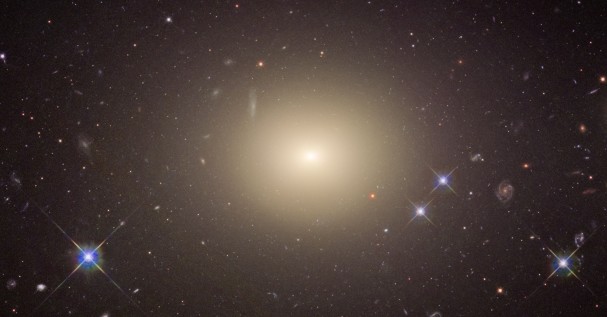I say: O my God, take me not away in the midst of my days, Thou whose years endure throughout all generations.
Of old Thou didst lay the foundation of the earth; and the heavens are the work of Thy hands.
They shall perish, but Thou shalt endure; yea, all of them shall wax old like a garment; as a vesture shalt Thou change them, and they shall pass away;

Three sources have recently drawn my attention to the likely state of our world in 100 billion years’ time.
First of these is the mini-series Everything – and Nothing by Jim Al-Khalili, where he presents our galaxy siting alone in the observable universe, expansion having taken all others beyond the horizon of visibility. I say our galaxy, but it will be a large elliptical galaxy formed by the merger of our own Milky Way and the Andromeda galaxies, both of which, over the next few billions years, will merge. In so doing, they will lose their lovely spiral structures and become like the rather humdrum object pictured above.
In Wonders of the Universe, Brian Cox tells us that all the medium and large stars will by then have gone out, and if we are still around, we will be huddled round the small but long-lived red dwarfs like campfires in the desert. However, in the night there will be no stars visible to the unaided eye – even the nearest red dwarf, Proxima Centauri, is too faint for binoculars.
And an article in the most recent (1st April 2011) New Scientist Empty universe: Cosmology in the year 100 billion – takes us there also.
But if you think that’s grim, you ain’t thought nothing yet. Black holes fill me with horror, but for me the Enduring Chill comes from an article in the back of one of my chemistry magazines a few years ago. It took us much further forward, to 10110 years on. Matter as we know it has almost disappeared, since proton decay has removed all hadrons from the universe and we are left with positrons balancing the electrons that were there before. Black holes have all evaporated by Hawking radiation, so apart from these negative and positive electrons, all that is left is an ocean of photons, most of them of very low energy.
And it’s not finished yet. Spaced apart as they may be, eventually – by 10145 years – all those electrons and positrons will collide, mutually annihilating to produce a pair of gamma rays. Though even these will not remain gamma for ever, as they increase in wavelength and decrease in energy with the continuing expansion of the universe.
Then it will be like this extract from A Paradoxical Ode, after Shelley, one of the Poems by James Clerk Maxwell.
Till, in the twilight of the gods,
When earth and sun are frozen clods,
When, all its energy degraded,
Matter to ether shall have faded;
We, that is, all the work we’ve done,
As waves in ether, shall for ever run
In ever-widening spheres through heavens beyond the sun.
Some decades later, this may have inspired Sir Arthur Eddington, in his famous book New Pathways in Science (first published 1935).
It would seem that the universe will finally become a ball of radiation . . . . The longest waves are Hertzian waves of the kind used in broadcasting About every 1500 million years this ball or radio waves will double its diameter; and it will go on expanding in geometrical progression for ever. Perhaps then I may describe the end of the physical world as — one stupendous broadcast.
So, I would rather leave you with some music. The second line of the refrain of this song, sung by one of the most beautiful voices on Planet Earth at this time, means “And the sighing of the flute continues after existence has been extinguished.” (Be warned – there’s a minute of instrumental music before she starts singing.)
Sources:
Biblical quote: Psalm 102 in the Jewish Publication Society's 1917 edition of the Hebrew Bible in English.
Picture: The giant elliptical galaxy ESO 325-G004 via the Wikipedia page Elliptical galaxy.





Comments